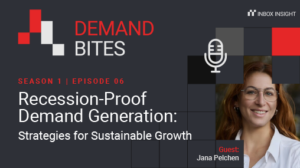The key to successful B2B demand generation is keeping your audiences continuously engaged.
This means sustaining their appetite for content and serving it to them in ways they can’t resist.
Content marketing generates over three times as many leads as outbound marketing and costs 62% less (Demand Metric).
As every B2B buyer has their own purchasing journey and obstacles, finding a way to satisfy everyone’s information needs can be a B2B marketing headache.
This article looks at the rise of on-demand content strategies as a simpler solution to a mounting B2B demand generation challenge. Used right, learn how you can generate more leads to fuel your sales pipeline…
Reading time: 3 minutes
You don’t have to look far or wide to see how streaming services such as Netflix and Spotify have shaped the consumer world. As predicted, the B2B world is catching up with its own take on binge consumption – on-demand content strategies.
What is an on-demand content strategy?
On-demand content is most commonly associated with webinars and videos that are traditionally live streamed. As the need to balance time zones, work schedules and production values are increasingly problematic, making content available on-demand has proven to not only overcome this challenge but also to bring a wealth of other benefits.
5 key benefits of an on-demand content strategy:
- Prolongs your content’s lifespan
- Transcends time zones and work schedule limitations
- Makes your content more accessible to prospects of all stages of the buyer’s journey
- Enables prospects to engage with content on their own terms
- Opens up opportunities to capture audience insights and track engagements
Does on-demand content only apply to webinars and videos?
No. Front runners have taken the concept of content made accessible on demand and applied it to their wider content strategy.
As a direct response to buyers’ self-directed content consumption preferences, making all your content accessible in one place, available in real-time and to be consumed on your own terms, is a savvy content marketing tactic that is enabling B2B marketers to reap many rewards…
Bundled nurturing content within a resource hub (rather than multiple emails) produced a 3X increase in lead to pipeline ratio. (Demand Gen Report)
Serving up your content on one centralized hub is much like offering an all-you-can-eat buffet. Unbound by the restriction of drip-fed emails, social posts or ads, your target audience can directly access the most relevant content that will shape their opinion and steer their B2B buying criteria, when and however they need it.
But simply relying on an asset library hosted on your website or owned channels, no longer cuts it. Market leaders are going one further to enrich the way they reach, engagement and convert their target audiences…
How to leverage 3rd party platforms for rented attention
91% of B2B marketers use content marketing to reach customers. (Content Marketing Institute).
Third party publishing platforms are a Mecca for information hungry B2B buyers on the hunt for trustworthy content such as thought leadership, reports and whitepapers.
Not only do these platforms have the audience numbers otherwise unattainable via your owned channels, they also provide a plethora of audience insights including action-based intent data and behavior trends.
Having these insights at your fingertips, enable you to track real-time trends as they break. This can give your campaigns that all important critical advantage, helping you keep your message on point and bang on time.
What’s more, rented attention from a platform with an established reputation helps to boost your own credentials as a trustworthy source of information. When B2B buyers crave authentic information, having your content associated with brands that already hold kudos among your chosen audiences, can carry a lot of clout. This can fast track relationship building and accelerate engagement:
95% of buyers are willing to share their name, company and email address in return for content (Demand Gen Report) and 60% of people are inspired to seek out a product after reading content about it (Demand Metric).
How is content repurposing a winning approach for on-demand content strategy
While a bottomless brunch of B2B content may seem like the dream for B2B information consumers, this concept could leave many B2B content marketers in a cold sweat.
The Content Institute of Marketing reports 32% of marketers think their content creation workflow is fair or poor. While 65% of people find it hard to produce engaging content (Zazzle Media).
If you’re concerned your content production is unable to keep pace, a highly effective marketing hack is content repurposing. Not only does this strategy help you squeeze more value from your content marketing budget, it opens up the amount of formats you can produce to satisfy the broad range of buyer stage appetites.
Repurposing the chapters of a whitepaper into stand-alone eBooks, checklists or cheatsheets is one example of how you can get more bang for your buck.
Another example is to turn key findings of an analyst report into a set of easy-to-digest infographics. Not only are these visually engaging, they provide a more accessible format for time starved readers or early engagers.
For more information on how you can create a wider breath and depth of content through embracing content repurposing techniques, check out our dedicated article:
6 Popular Content Re-Purposing Quick-Wins You Can Use Today
How on-demand content supports the sales and marketing pipeline
47% of buyers viewed 3-5 pieces of content before engaging with a sales rep (Demand Gen Report).
While we can’t control how people consume our content, we can lay out the most appealing spread that caters for all content consumption requirements. This optimizes your touchpoints for engagement helping to encourage the reading of multiple assets, while simultaneously enabling your readers to maintain control over what, when and how they want to interact with your resources.
This provides the opportunity for your audiences to self-educate on your best content. By fulfilling their information needs you are sustaining a continuous value exchange punctuated with opportunities to interact with your sales and marketing team.
Having one platform to capture multiple audience interactions lends itself well to more streamlined analytics. Depending on your platform, lead scoring or categorization are just a few ways crucial touchpoints can be captured in real-time, ensuring your sales and marketing team never miss a beat.
For more information on how to get the most value from your content through reaching and engaging the right audiences, get in touch with our team of specialists.






